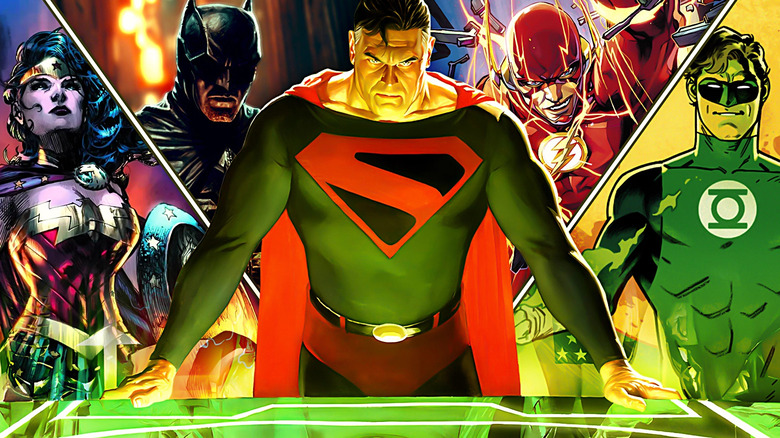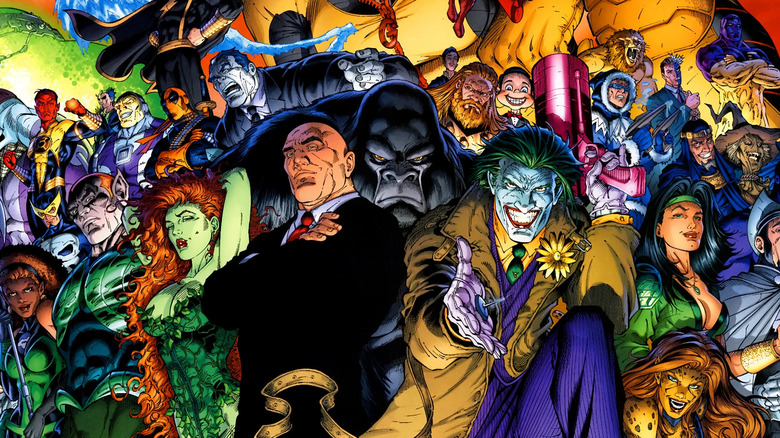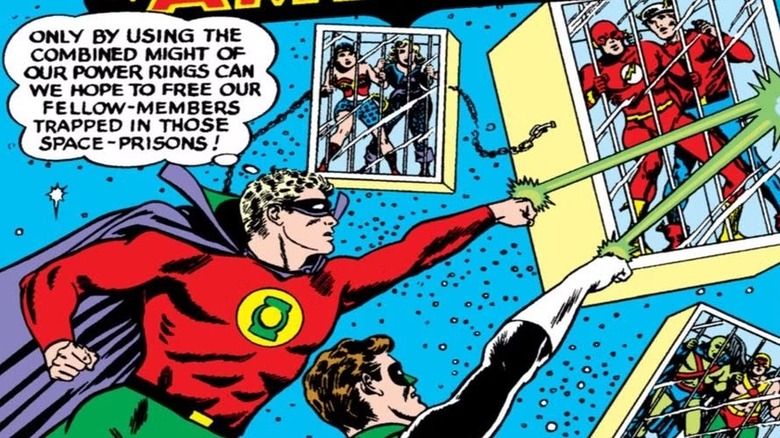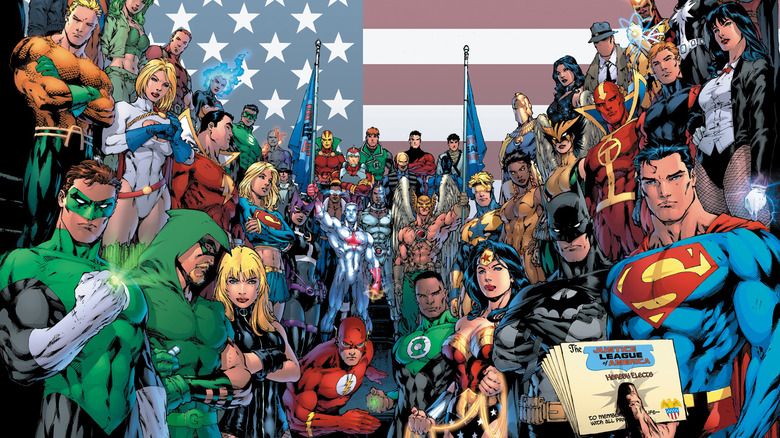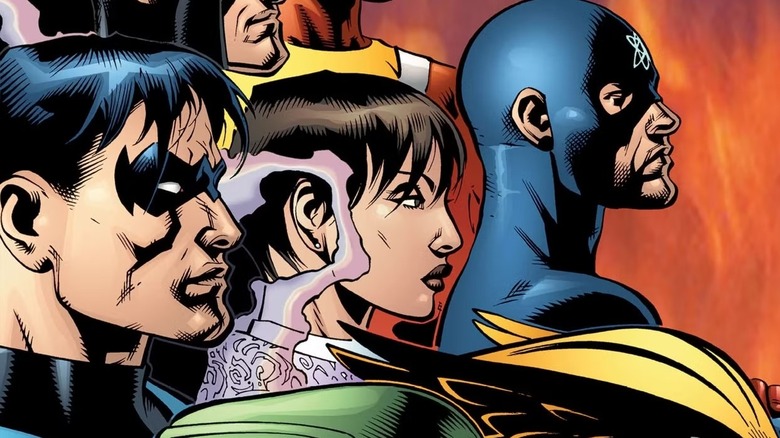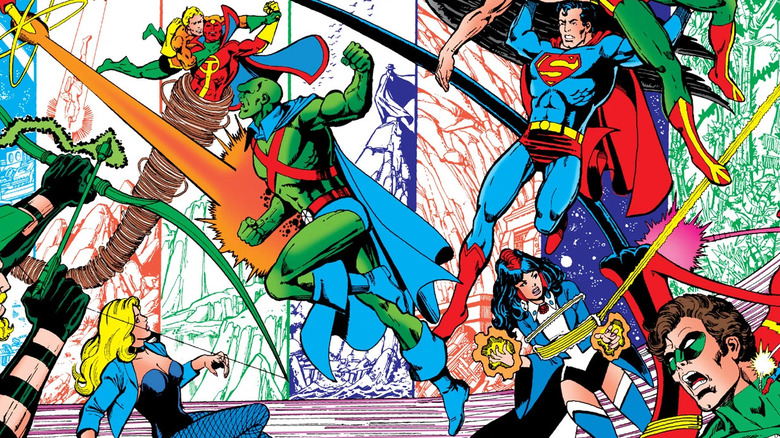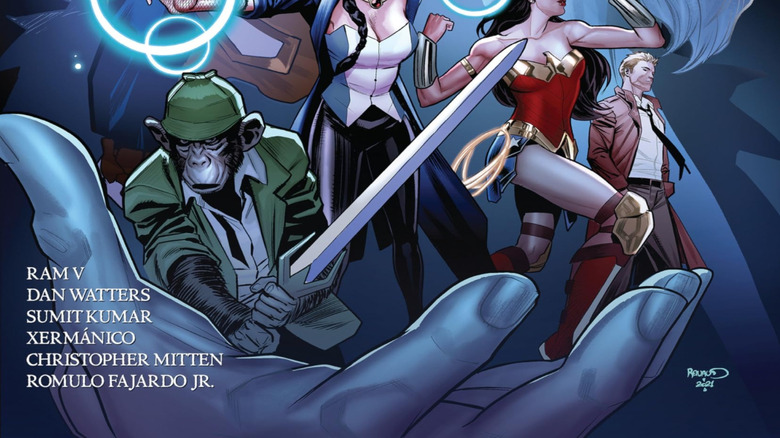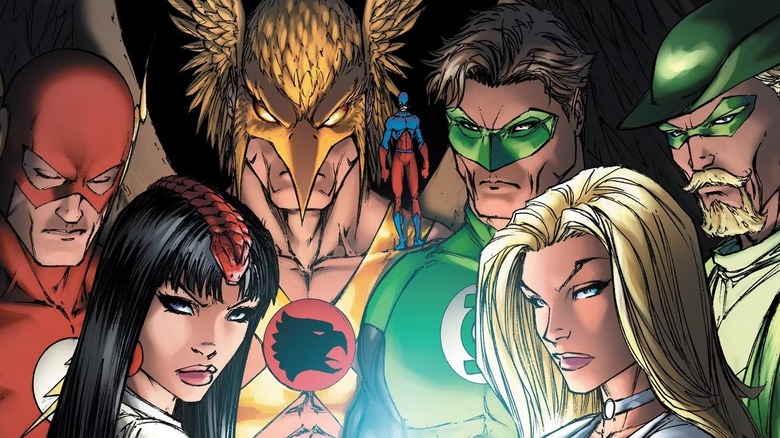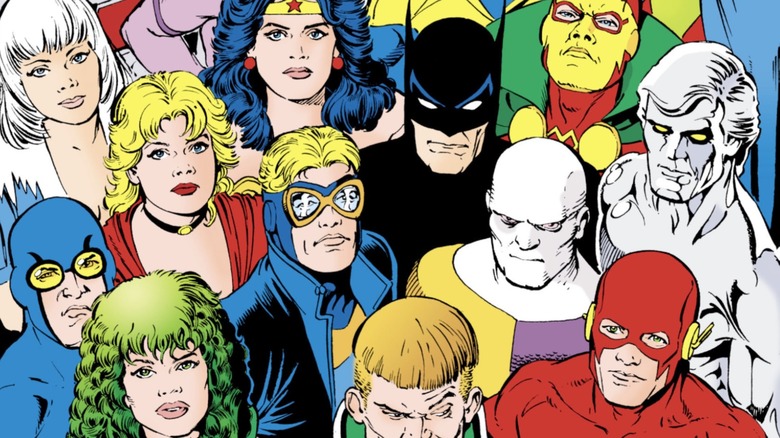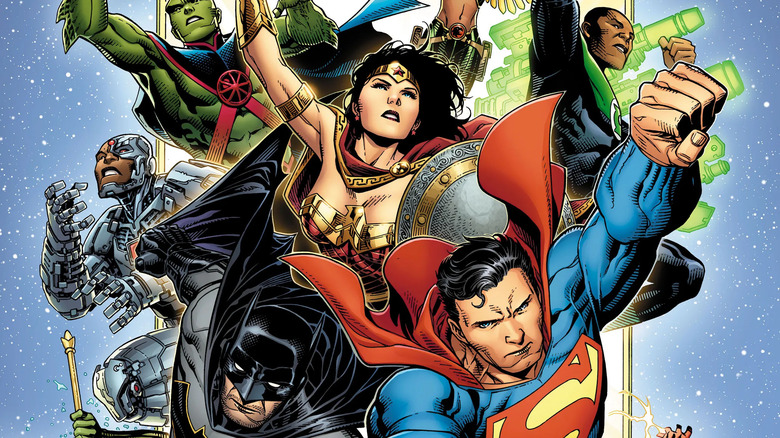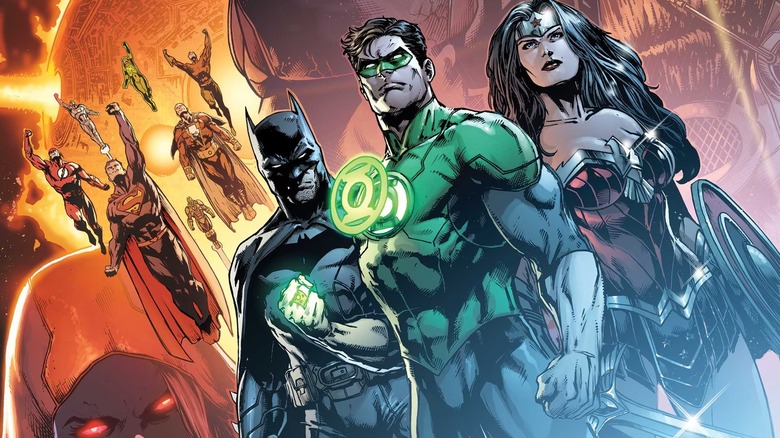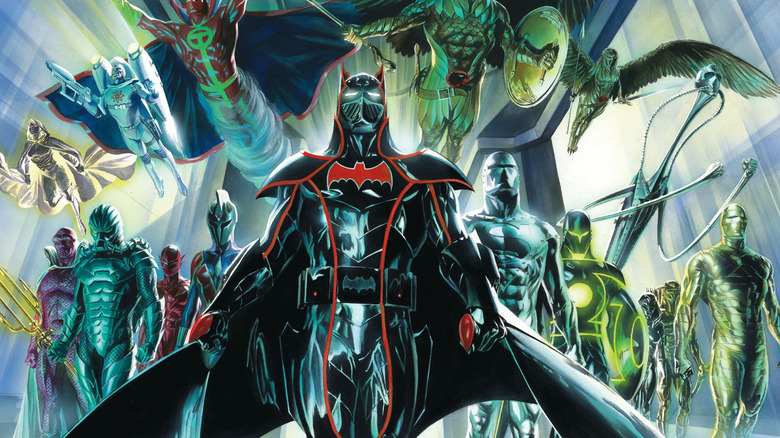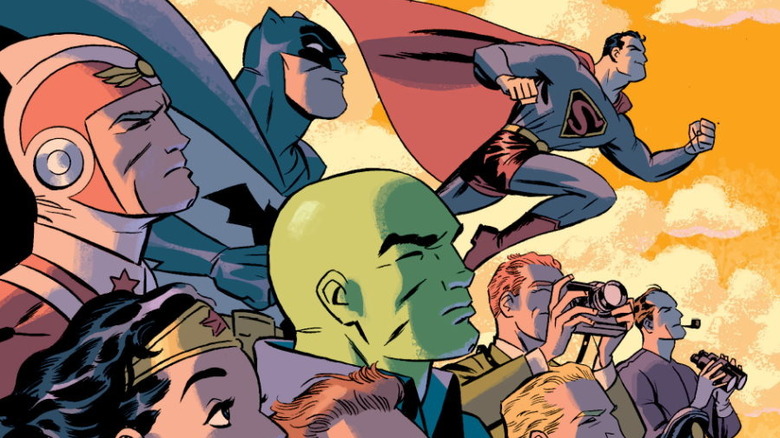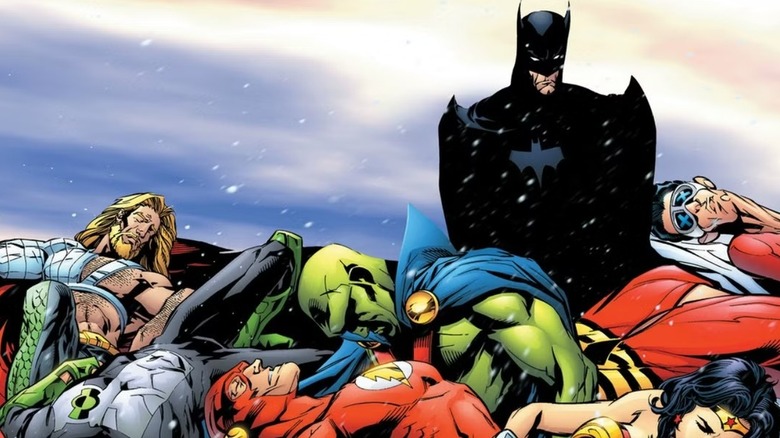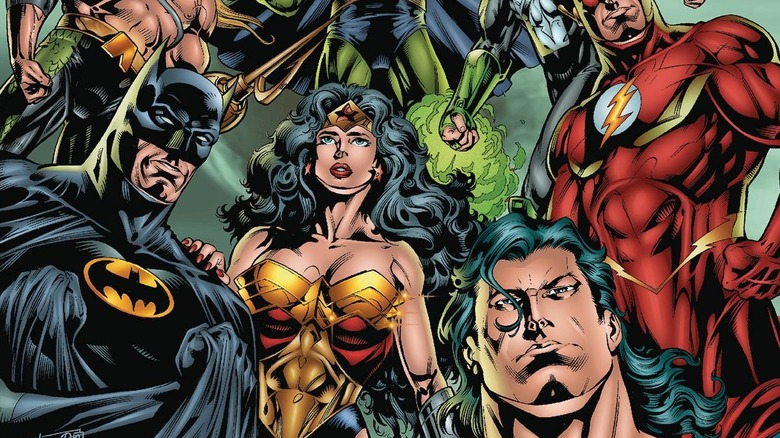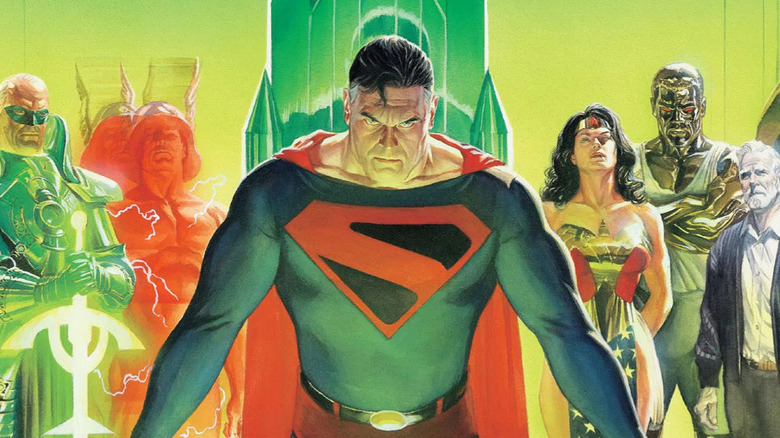The 15 Best Justice League Comics Of All Time, Ranked
We may receive a commission on purchases made from links.
While the Marvel Universe has the Avengers and X-Men, the DC Universe has the Justice League as its premier superhero team. Though the 2017 "Justice League" movie became a box office disaster that doomed the DC Extended Universe, there are countless great comic stories chronicling the team's adventures. Whether focused on its most prominent heroes or more obscure characters, the Justice League casts a wide spotlight on the DCU. Some of the biggest names in comic book history have woven their own Justice League stories, defining and refining the wider DCU in the process.
The best Justice League stories combine the bombast expected from the DCU's greatest team without losing sight of the stakes for its fan-favorite characters. More than just a team-based approach to superhero tropes, effective Justice League tales celebrate the entire DCU. Here are the 15 best Justice League comics of all time ranked, ready for curious readers to check out.
15. Justice League of America by Dwayne McDuffie
One celebrated creative voice in comic books and animation who has gone far too soon was writer Dwayne McDuffie, who passed away in 2011 at the age of 49. McDuffie played an integral role within Milestone Media, including its acclaimed animated series "Static Shock," while also working on DC and Marvel properties. This included a memorable run on "Justice League of America" from 2007 to 2009, which started with the Justice League taking on the all-star supervillain ensemble the Injustice League. During his run on the title, McDuffie primarily worked with artist Ed Benes, who had relaunched the series several years prior.
McDuffie had previously worked for years on DC Animated Universe shows, including "Justice League" and "Justice League Unlimited." Drawing from that experience, McDuffie's work really highlighted the comic book team's ensemble nature, and not solely focusing on its most iconic characters. Compared to the preceding creative team's more cerebral take on the Justice League, McDuffie and Benes offered a more action-oriented and cathartic read. When it comes to straightforward Justice League adventures from DC's late 2000s period, McDuffie's "Justice League of America" run offers a satisfying ride.
14. Crisis on Earth-One and Earth-Two
Gardner Fox and Mike Sekowsky, along with editor Julius Schwartz, created the Justice League in 1960 with "The Brave and the Bold" #28. This led to the team getting its own eponymous comic book series later that year with Fox and Sekowsky resuming their respective writer and artist roles. The following year, Fox and Carmine Infantino introduced the DC multiverse in "The Flash" #123, with the company's Golden Age heroes' world retroactively identified as Earth-Two. After that story's success, Fox and Sekowsky expanded the premise's scope with 1963's "Justice League of America" #21 and #22.
Collectively titled "Crisis on Earth-One and Earth-Two," the story has the two Earths' teams unite to combat villains from both their worlds. The two-part tale not only expanded on the multiverse concept but also delivered DC's most cosmically epic story at that time. Seeing pairings like the distinctly different Green Lanterns meet for the first time, let alone work together, remains an enduring treat. A highlight from the Justice League's earliest adventures, Fox and Sekowsky's story is included in the title's Silver Age Vol. 3 collection.
13. Justice League of America by Brad Meltzer and Ed Benes
Following the 2005 crossover storyline "Infinite Crisis," DC Comics relaunched several of its classic titles, including "Justice League of America." This new volume was kick-started by best-selling writer Brad Meltzer and popular artist Ed Benes in 2006, with Superman, Batman, and Wonder Woman reuniting to reform the team. Meltzer and Benes' run was deeply rooted in the canon of the DCU, especially the in-universe history of the Justice League. This was perhaps best exemplified with the Justice League's team-up with the Justice Society and Legion of Super-Heroes in "The Lightning Saga."
This isn't to say that Meltzer and Benes don't bring the superhero action to their "Justice League of America" run. The team's first adventure has them take on an intelligent and calculating Solomon Grundy, targeting the hero Red Tornado. But Meltzer and Benes provide a more grounded and intimate take on the Justice League, emphasizing each of the members' core humanity. Meltzer's "Justice League of America" run has since been collected in a deluxe edition, compiling his postmodern approach to the DCU's greatest team.
12. JLA by Joe Kelly and Doug Mahnke
Writer Joe Kelly had some big creative shoes to fill, following Grant Morrison and Mark Waid's well-received runs on "JLA." Collaborating primarily with artist Doug Mahnke, Kelly's run on the title began with 2001's "JLA" #61, with the team pushed to their limits. The centerpiece of Kelly's Justice League stories is "The Obsidian Age," with the team exploring the fallout of Aquaman's sudden disappearance. Before the team regroups, the world is magically tampered with, leading Batman to recruit a surprising new iteration of the Justice League.
Kelly and Mahnke's run on "JLA" wasn't as high-concept as Morrison or steeped in the lore as Waid's, but no less entertaining. The creative team would reunite to launch the 2004 maxi-series "Justice League Elite," introducing a black ops variation of the familiar team, with new characters. Kelly offered a more personal touch to the characters and their insights, though not as postmodern as Meltzer's approach. A commendable continuation from their predecessors' celebrated runs, Kelly and Mahnke helped usher the Justice League into the 21st century.
11. A League Divided
As one of the most influential superhero comic book writers ever, Gerry Conway wrote for several major publishers, including the story where Gwen Stacy died in Marvel's Spider-Man comics. Moving to DC in the '70s, Conway was the main writer on "Justice League of America" for eight years, from 1978 to 1986. Defining DC's team series until the company reset its continuity in the '80s, Conway balanced stories between the League's most famous members and its more obscure heroes. Conway worked with a variety of artists during his lengthy tenure on the title, largely with the series' longtime artist Dick Dillin.
The highlight of Conway's run is the double-sized anniversary issue, "Justice League of America" #200, which featured an ambitious tale titled "A League Divided." Published in 1981, the story had the founding members of the League mind-controlled, pitting them against the newer recruits. Joining Conway was a whole cavalcade of superstar artists, from veterans like Gil Kane and Carmine Infantino to newer talent like George Pérez and Jim Aparo. A beautiful celebration of the title's history and all things DC, the extensive creative team left it all on the field for this story.
10. Justice League Dark by Ram V and Sumit Kumar
The idea of a supernatural and horror-tinged Justice League, or Justice League Dark, is something that started in 2011 when DC Comics rebooted its main comic book line. After an acclaimed run on "Swamp Thing," writer Ram V turned his attention to DC's other paranormal heroes by taking the reins on "Justice League Dark." Picking up the narrative threads from the preceding creative team, Ram made the story his own, joined by a number of collaborators, including artist Sumit Kumar. The run had Zatanna struggle to control her powers while facing a terrifying villain known as the Upside-Down Man.
Ram and Kumar's run on "Justice League Dark" played with comic book format with a self-aware wink to readers as it progressed. At the same time, the creative team brought the superhero bombast and horror elements expected from the title. And for all the high-concept storytelling Ram brought to the proceedings, he still had plenty of fun with the characters, even slipping in a sly nod to Freddie Mercury. The Justice League Dark has had plenty of great stories, but Ram and Kumar's run stands out.
9. Identity Crisis
Before his "Justice League of America" run, writer Brad Meltzer teamed up with Rags Morales and Michael Blair for the 2004 limited series "Identity Crisis." The story is essentially a murder mystery as the superhero community is rocked by the killing of Sue Dibny, the Elongated Man's beloved wife. As the heroes investigate who could've committed the heinous crime, they learn it's not only someone close to their own but uncover dark secrets about the Justice League. This began a series of events that rocked the DCU to its core and unraveled the trust within the League.
Upon its publication, "Identity Crisis" was not without controversy over its treatment of its female characters and questionable moral decisions by the heroes. What Meltzer, Morales, and Blair did was create a deconstructive view of the vaunted DC icons and the complicated world they live in. The repercussions to the wider DCU would continue for years afterwards, especially to Batman and Deathstroke. A divisive examination of DC's greatest heroes, "Identity Crisis" certainly got fans talking, earning it a spot on this list.
8. Justice League International by Keith Giffen, J.M. DeMatteis, and Kevin Maguire
At a time when it felt like mainstream superhero comics were becoming steadily more self-serious, 1987's "Justice League International" kept its tone fun without compromising narrative stakes. Launched by Keith Giffen, J.M. DeMatteis, and Kevin Maguire, the series saw the formation of the first Justice League after the seminal "Crisis on Infinite Earths" crossover story. The initial incarnation lacked many of the DCU's heaviest hitters, favoring more misfit superheroes like Booster Gold and Blue Beetle. The team is backed by unscrupulous businessman Maxwell Lord, who sees the ensemble as a PR coup.
While maintaining the superhero spectacle, Giffen, DeMatteis, and Maguire's run was the funniest Justice League ever. Seeing the interpersonal conflicts form within the ensemble, particularly around its arrogant Green Lantern Guy Gardner, made for hilarious moments between missions. But when the chips were down, the JLI was still a competent squad that defended the DCU to the best of their awesome abilities. A breath of fresh air compared to an industry growing grittier with its costumed escapism, "Justice League International" captured the genre's heartfelt charm.
7. Justice League by Scott Snyder
After penning some of the best Batman comics, writer Scott Snyder expanded his focus to the entire DCU with a run on "Justice League" in 2018. Working with a rotating roster of artists, Snyder brought a cosmic scope to the title with the introduction of a source of raw multiversal power known as the Totality. The League worked to prevent the Totality from falling into the wrong hands, discovering the villains had formed a team of their own, the Legion of Doom. Backing the supervillain ensemble was the omnipotent figure Perpetua, imbuing Lex Luthor with a fraction of her otherworldly powers.
Available in a line of deluxe edition collections, Snyder's "Justice League" run was unafraid to get weird, embracing the DCU's creative possibilities. From a Hall of Justice that also served as a mobile battle station to the team shrinking down to enter Superman's body, Snyder's run got wonderfully wacky. The run would set up Snyder's heavy metal-themed 2020 crossover event "Dark Nights: Death Metal," which contained the true end to the story. With a wide scope touching virtually every corner of the DCU, Scott Snyder's "Justice League" run steered the entire DC Comics line.
6. Justice League by Geoff Johns
In 2011, DC Comics rebooted the DCU's continuity in a publishing initiative dubbed the New 52 after the first 52 comic book series included with this relaunch. Leading the charge was "Justice League," which was written by Geoff Johns, with Jim Lee as its initial series artist. The overarching villain of Johns' run was Darkseid, reestablished as a foe for the entire multiverse. In between penning battles against the Crime Syndicate and Aquaman's brother Orm, Johns took advantage of the new continuity to change the team dynamics, including a romance between Superman and Wonder Woman.
Just as he had prior to the New 52, Johns revisited and slightly remixed elements of DC lore to weave modern stories with the fan-favorite characters. He balanced his ensemble well, retaining the heroes' appeal even after the wholesale revisions to their histories. Just as "Justice League" ushered in the New 52, it signaled the return of the classic canon, with Johns joined by artist Jason Fabok for the climactic "Darkseid War" story. The tip of the narrative spear to the DCU, Johns' "Justice League" run is a prime example of the New 52's more alluring possibilities.
5. Justice
After imagining the possible dystopian future of the Marvel Universe in 1999's "Universe X," Alex Ross and Jim Krueger reteamed for the 2005 maxi-series "Justice." Set outside of the main DCU continuity, the story features the classic Silver Age Justice League and their biggest nemeses. After the Legion of Doom endures a shared dream of the heroes failing to prevent nuclear armageddon, they take matters into their own hands to avert this possible future. The League finds itself on the defensive as DC's greatest villains learn their secret identities and attack them.
As much a love letter to the '70s animated series "Challenge of the Super Friends" as DC's Silver Age history, "Justice" features Ross and Krueger in fine form. The story gives each of the main Justice League members their due while weaving in some less prominent heroes with time to shine. As with any project with Ross, the artwork is breathtakingly beautiful, with Ross working with Doug Braithwaite to bring this tale to visual life. A perfect slice of one of DC's most iconic eras, "Justice" captures everything right with the timeless history of the DCU.
4. DC: The New Frontier
While Alex Ross may bring a photorealistically painted perspective to DC properties, the late comic book creator Darwyn Cooke opted for a more clean-lined approach. Cooke's magnum opus is the 2004 limited series "DC: The New Frontier," which he wrote and drew. The story is a non-canonical transition between DC's inciting Golden Age from the '30s and '40s to its more sci-fi inspired Silver Age that began in the '50s. The story has the Justice Society ostracized by the federal government as a new generation of heroes rises to take on an extraterrestrial invasion.
Cooke was just one of those artists who was born to draw DC characters, and "The New Frontier" more than proves that. His artistic sensibilities worked particularly well for Silver Age characters like Hal Jordan and Barry Allen, capturing the stylized retro aesthetic evoking their debuts. And just how effectively Cooke employs the extensive ensemble cast is impressive, including several forgotten DC properties like the Losers and Slam Bradley. A gorgeously realized exploration of DC's foundational history, "DC: The New Frontier" is Cooke firing on all cylinders.
3. Tower of Babel
In a superhero universe full of demigods, Batman is something of an outsider, relying on his wits and highly trained human body. That discrepancy, along with the Dark Knight's own deep-seated trust issues, informs Mark Waid and Howard Porter's most acclaimed "JLA" story, "Tower of Babel." The 2000 tale has Batman distracted by the sudden disappearance of his parents' bodies, leading him on a global search for them. In his absence, a villain breaks into the Bat-Computer, steals Batman's contingency plans to neutralize the Justice League if they ever went rogue, and enacts them.
Waid would stay on as the writer for "JLA" after "Tower of Babel," penning the memorable "Terra Incognita," but the 2000 story is his best work on the title. Along with Porter, Waid crafts a mystery that leans into Batman's paranoia and the Justice League's greatest weaknesses. In doing so, the Caped Crusader showcased exactly why he deserves to be on a team with powerhouses like Superman and Wonder Woman. Few comic creators have the level of knowledge and intuition for the DCU as Waid, and he uses that to his advantage here.
2. JLA by Grant Morrison and Howard Porter
Scottish writer Grant Morrison is one of DC's most influential creators of all time, with Morrison's Batman run one of the key comics behind James Gunn's DC Universe. Morrison teamed up with artist Howard Porter to launch "JLA" in 1996, offering a similarly high-concept take on the DCU's greatest team. Morrison and Porter start with the seven most famous heroes on the team before bringing in more offbeat characters as their run progresses. Largely staying together as the title's main creative team through issue #41, Morrison and Porter mixed classic enemies and new threats across their celebrated run.
Morrison and Porter present the Justice League as a modern pantheon of demigods, avoiding the intimate and postmodern takes employed by some of their successors. This was often juxtaposed by similarly vaunted threats, be it White Martians or Darkseid, the latter positioned as the ultimate evil. Finally, there were no other comic creators who were as effective as using Superman while his powers were electricity-based than Morrison and Porter. With the best creative team on a main Justice League title, "JLA" is a full showcase for the ensemble.
1. Kingdom Come
Mark Waid and Alex Ross proved to be a creative team made in heaven, at least judged by their resulting collaboration, 1996's "Kingdom Come." Set in an alternate future for the DCU, Superman goes into a self-imposed exile after the public embraces heroes that openly employ lethal force. After Kansas is obliterated in a super-powered showdown, Superman reemerges to reform the Justice League. This places him on a collision course with dissenting heroes, the organized supervillains, and uneasy world governments.
While purists may argue that "Kingdom Come" is more of a broader DCU story than a Justice League one, we're willing to give it a pass. After all, Waid and Ross created one of the best DC comics ever, as a reaction to the rising popularity of antihero figures at the time. At its core, "Kingdom Come" is about the superhero community relearning how to trust and inspire each other. This ethos has always been key to the Justice League and any superhero team, making "Kingdom Come" the best Justice League story ever.
